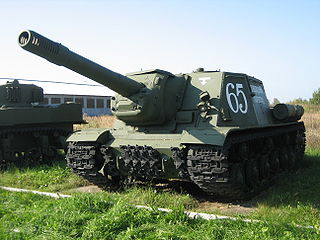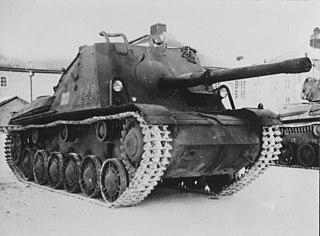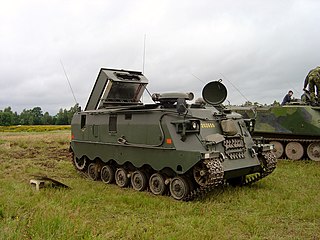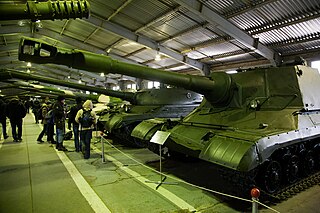
An assault gun is a type of self-propelled artillery which uses an infantry support gun mounted on a motorized chassis, normally an armored fighting vehicle, which are designed to provide direct fire support for infantry attacks, especially against other infantry or fortified positions. Assault guns were pioneered by the Soviet Union and Nazi Germany during the 1930s, initially being self-propelled guns with direct fire in mind, with Germany introducing the first purpose-built assault gun, the Sturmgeschütz III, in 1940.

A tank destroyer, tank hunter or tank killer is a type of armoured fighting vehicle, predominantly intended for anti-tank duties. They are typically armed with a direct fire artillery gun, also known as a self-propelled anti-tank gun, or missile launcher, also called an anti-tank missile carrier. The vehicles are designed specifically to engage and destroy enemy tanks, often with limited operational capacities.

Self-propelled artillery is artillery equipped with its own propulsion system to move toward its firing position. Within the terminology are the self-propelled gun, self-propelled howitzer, self-propelled mortar, and self-propelled rocket artillery. They are high-mobility vehicles, usually based on continuous tracks carrying either a large field gun, howitzer, mortar, or some form of rocket/missile launcher. They are usually used for long-range indirect bombardment support on the battlefield.

The ISU-152 is a Soviet self-propelled gun developed and used during World War II. It was unofficially nicknamed Zveroboy in response to several large German tanks and guns coming into service, including Tigers and Panthers. Since the ISU-152's gun was mounted in a casemate, aiming it was awkward, and had to be done by repositioning the entire vehicle using the tracks. Therefore, it was used as mobile artillery to support more mobile infantry and armor attacks. It continued service into the 1970s and was used in several campaigns and countries.

The Stridsvagn 103, also known as the Alternative S and S-tank, is a Swedish Cold War-era main battle tank, designed and manufactured in Sweden. "Strv" is the Swedish military abbreviation of stridsvagn, Swedish for chariot and tank, while the 103 comes from being the third tank in Swedish service to be equipped with a 10.5 cm gun.

The Jagdtiger is a German casemate-type heavy tank destroyer (Jagdpanzer) of World War II. It was built upon the slightly lengthened chassis of a Tiger II. Its ordnance inventory designation was Sd.Kfz. 186.

The Centurion was the primary British Army main battle tank of the post-World War II period. Introduced in 1945, it is widely considered to be one of the most successful post-war tank designs, remaining in production into the 1960s, and seeing combat into the 1980s. The chassis was adapted for several other roles, and these variants have remained in service. It was a very popular tank with good armour, mobility, and a powerful main armament.

Sturmtiger was a World War II German assault gun built on the Tiger I chassis and armed with a 380mm rocket-propelled mortar. The official German designation was Sturmmörserwagen 606/4 mit 38 cm RW 61. Its primary task was to provide heavy fire support for infantry units fighting in urban areas. The few vehicles produced fought in the Warsaw Uprising, the Battle of the Bulge and the Battle of the Reichswald. The fighting vehicle was known by various informal names, among which the Sturmtiger became the most popular.

Luftvärnsrobotvagn 701 is a Swedish self-propelled anti-aircraft vehicle armed with the locally produced short range RBS 70 surface-to-air missile system. The lvrbv 701 is not NBC-protected and has no night vision equipment. Except for the armament, lvrbv 701 is identical to the Pansarvärnsrobotbandvagn 551 ATGM carrier. Both vehicles were built from the chassis of obsolete Infanterikanonvagn 103 self-propelled guns. Conversion to the lvrbv 701 was done during the 1980s and the vehicle was taken out of active service around the year 2000.

The infanterikanonvagn 91, lit. 'infantry cannon wagon 91', was a high mobility assault gun that was developed to meet the operational requirements of the Swedish Army. It was designed and manufactured by Hägglund & Söner and employed common components with the Pbv 302 armoured personnel carrier series. The first prototypes of the ikv 91 were completed in 1969 with production running from 1975 until 1978. In total, 212 were manufactured.

15,5 cm bandkanon 1, meaning "15.5 cm (6.1 in) tracked cannon 1", was a Swedish self-propelled artillery vehicle in use with the Swedish Army from 1967 to 2003, developed by Aktiebolaget Bofors. Its product name was Bofors Vagnkanon 155 mm L/50, meaning roughly "Tracked Automotive Gun 155 mm L/50". Bkan 1 was one of the world's heaviest and most powerful self-propelled artillery vehicles in use during its service.

Stridsvagn 74 was a Swedish light tank in use with the Swedish Army from 1958 to 1984. It was a modification of the older stridsvagn m/42 medium tank, which was phased out of service in the early 1950s. Instead of scrapping the vehicles altogether, the chassis were used to build a new tank which could be used as a supplement to the newly bought stridsvagn 81. The turret of the strv 74 was completely new, with a 75 mm high-velocity gun based on an older anti-aircraft gun Bofors 75 mm Model 1929, engines and transmission were modified or changed from the strv m/42, wider tracks and a separate electrical motor for turret traverse was introduced while retaining manual traverse as a backup.

The WZ-551 is a Chinese wheeled infantry fighting vehicle family. The name WZ-551 actually covers two families of vehicles with the official designations in the People's Liberation Army (PLA) – Type 90 and Type 92. Over 3,000 WZ-551s are in service with the PLA, where they are used by medium mechanized infantry units.

The Leichter Kampfwagen II, commonly known as the LK II, was a light tank designed and produced in limited numbers in Germany in the last year of World War I. A development of the LK I, it incorporated a fixed rear superstructure and had two distinct configurations; one variant being armed with the MG 08/15, and the other being armed with a 5.7 cm Maxim-Nordenfelt gun. Its armor was 8 to 14 mm thick, which led to a total weight of 8.75 tons. Power was provided by a Daimler-Benz Model 1910 4-cylinder 55-60 hp gasoline engine, giving a maximum speed of 14 to 18 km/h with range of 65–70 km.

Stridsvagn m/42 was a Swedish medium tank in service in the World War II period. Known by its manufacturer AB Landsverk as Lago II-III-IV, it fielded a 75 mm L/31 gun, the first of its size in a Swedish tank. It entered service with the Swedish Army in April 1943. Modern in design and mobile, a total of 282 were produced.

Heavy tank project Emil, known under the cover name of Kranvagn or KRV for short, was a heavy tank developed secretly in Sweden during the early 1950s; Kranvagn, meaning mobile crane, was a cover-name. The intention was to replace the Swedish Army's disparate tank fleet with a tank that could counter the Soviet IS series heavy tanks and be upgraded continuously. The initial design, in 1950, proposed mounting a 10.5 cm autoloader in an oscillating turret. Due to its size, weight and power to weight it was considered by many to be more of a medium tank than a heavy tank.

This article deals with the history and development of tanks employed by the military of Sweden, from the interwar period, and World War II, the Cold War and modern era.

The Pansarvärnskanonvagn m/43 was a tank destroyer developed by Landsverk.

The Pansarvärnsrobotbandvagn 551 was a tank destroyer developed by Landsverk and Hägglund & Söner.

The Object 268 was a prototype Soviet tank destroyer developed from 1952 to 1956 by the Kirov factory, Leningrad, on the basis of the T-10 heavy tank.





















